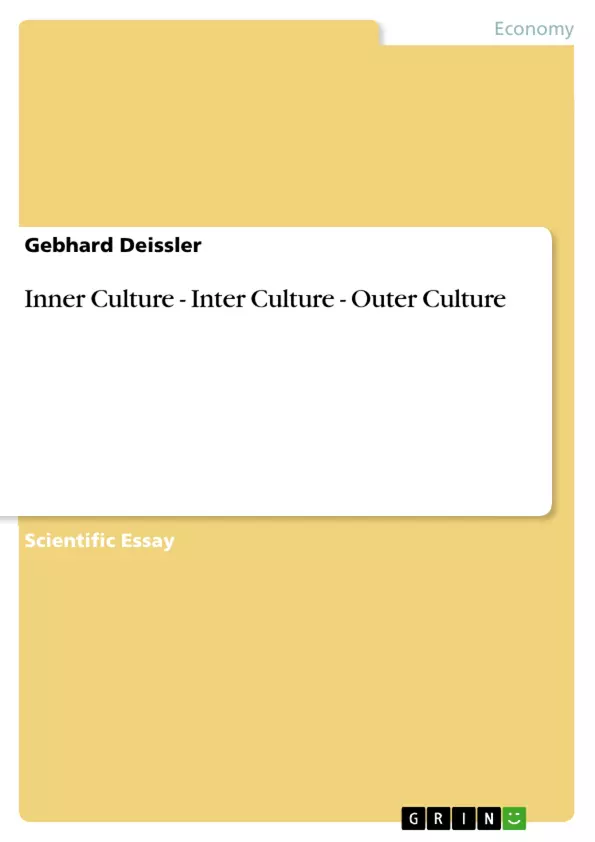Inner culture refers to an art and science of perception, of creative perception and processing of culture – which impact the perception of cultural diversity as well as its interrelated processes and outcomes. This expanded contextualization of culture leads to enhanced management options and capabilities.
From this reflection a number of models will emerge which locate culture and its various aspects contained in the threefold expression in an expanded micro-macrocosmic continuum (this term refers to the totality of the culture phenomenon) which includes the manager and the managed and where the processing and managing of culture can become less complex as well as more effective, because complexity is meaningfully structured under a new integrative roof of the human constitution.
Table of Contents
- Inner Culture
- Inter Culture
- Outer Culture
Objectives and Key Themes
The objective of this work is to explore the interconnected triad of inner, inter, and outer culture, providing new insights into culture and its management. It aims to expand the understanding of inner culture beyond a simple horizontal perception, incorporating a vertical dimension that considers the levels of cultural perception. This expanded view leads to enhanced management capabilities.
- Inner Culture: Exploring the art and science of perception and its impact on cultural diversity.
- Intercultural Interaction: Examining how inner cultural perspectives influence interactions with outer cultures.
- Quantum Cultural Optic: Utilizing the quantum paradigm as a metaphorical framework to understand cultural perception.
- Cultural Perception and Management: Analyzing the effects of different perceptual approaches on cultural management.
- The Inner-Outer Culture Continuum: Investigating the interaction and potential disconnection between inner and outer cultural spaces.
Chapter Summaries
Inner Culture: This chapter introduces the concept of inner culture, moving beyond traditional definitions to incorporate a vertical dimension of perception. It argues that inner culture is not merely the collective programming of the mind, but also an art and science of creative perception that significantly influences how individuals process and understand cultural diversity. The author introduces the concept of "quantum cultural optic," drawing analogies from quantum physics (Bohr's complementarity and Heisenberg's uncertainty principles) to illustrate how different perceptual lenses (atomistic vs. holistic) shape the understanding and management of culture. This approach highlights the importance of the observer's position in shaping the perception of culture, proposing that the choice between focusing on individual cultures or the unified field of human civilization impacts the effectiveness of cultural management.
Keywords
Inner culture, inter culture, outer culture, cultural perception, cultural management, quantum cultural optic, complementarity principle, unity-diversity duality, intercultural effectiveness, cultural continuum.
FAQ: A Comprehensive Language Preview
What is the main topic of this text?
The text explores the interconnectedness of inner, inter, and outer culture, offering a novel perspective on culture and its management. It expands the understanding of inner culture by incorporating a vertical dimension of perception, leading to improved management strategies.
What are the key themes explored in this text?
The key themes include: inner culture (exploring perception and its impact on cultural diversity), intercultural interaction (how inner perspectives influence interactions with outer cultures), quantum cultural optic (using quantum physics as a metaphorical framework for cultural perception), cultural perception and management (analyzing the effects of different perceptual approaches), and the inner-outer culture continuum (investigating the interaction between inner and outer cultural spaces).
What is meant by "inner culture" in this context?
Inner culture, as defined in this text, goes beyond traditional definitions to encompass a vertical dimension of perception. It's presented not just as collective programming but also as an art and science of creative perception that significantly impacts how individuals process and understand cultural diversity.
How does the text utilize the concept of "quantum cultural optic"?
The text employs the quantum paradigm, specifically Bohr's complementarity and Heisenberg's uncertainty principles, as a metaphorical lens to understand cultural perception. It suggests that different perceptual approaches (atomistic vs. holistic) shape our understanding and management of culture, highlighting the observer's influence.
What is the significance of the "inner-outer culture continuum"?
The concept investigates the dynamic interplay and potential disconnect between inner (personal perceptions and beliefs) and outer (external cultural manifestations) cultural spaces. Understanding this interaction is crucial for effective cultural management.
What are the objectives of this work?
The primary objective is to provide new insights into the interconnected triad of inner, inter, and outer culture and to enhance understanding of cultural management. It aims to move beyond a simplistic view of inner culture and incorporate a vertical dimension of perception for improved management effectiveness.
What are the chapter summaries included in the preview?
The preview includes a summary of the "Inner Culture" chapter, focusing on its expanded definition incorporating a vertical dimension of perception. It highlights the introduction of "quantum cultural optic" and its application in understanding cultural perception and management based on different perceptual lenses.
What are the keywords associated with this text?
Keywords include: inner culture, inter culture, outer culture, cultural perception, cultural management, quantum cultural optic, complementarity principle, unity-diversity duality, intercultural effectiveness, and cultural continuum.
What is the structure of the provided preview?
The preview provides a comprehensive overview, including a table of contents, objectives and key themes, chapter summaries, and keywords. This structure allows for a clear and structured understanding of the text's content and scope.
For whom is this text intended?
While the preview doesn't explicitly state the target audience, the academic nature of the content and the structured analysis suggest it's intended for scholars, researchers, and professionals in fields related to cultural studies, management, and potentially, those interested in interdisciplinary approaches to understanding culture.
- Citar trabajo
- D.E.A./UNIV. PARIS I Gebhard Deissler (Autor), 2010, Inner Culture - Inter Culture - Outer Culture, Múnich, GRIN Verlag, https://www.grin.com/document/159128



